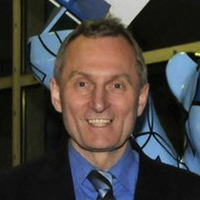Obituary: Ludwig Elsner
By Angelika Bunse-Gerstner, Jörg Liesen, Volker Mehrmann, and Reinhard Nabben
Ludwig Elsner, 1939-2023. Photo courtesy of Angelika Bunse-Gerstner.
Ludwig Elsner, professor emeritus of mathematics at Bielefeld University, passed away on February 25, 2023, in Halle Westfalen, Germany. He was 84 years old. Ludwig was well known for his important work in linear, multilinear, and numerical linear algebra.
Ludwig was born on January 17, 1939, in Groß Strehlitz, Upper Silesia, in what is now Poland. He studied mathematics from 1958 to 1963 at the University of Hamburg, including two semesters at the University of Freiburg — where he met his future wife, Margarita. After receiving his diploma, Ludwig earned his Ph.D. from the University of Hamburg under the supervision of Lothar Collatz. He defended his thesis on “Eigenvalue Inclusion Theorems for Non-normal Matrices” in 1965.
Ludwig remained at the University of Hamburg and completed his habilitation in 1969. In 1971, he began an associate professorship at the Friedrich-Alexander University of Erlangen-Nuremberg. He later accepted a full professorship in numerical mathematics at Bielefeld University, where he taught until his retirement in 2004.
At Bielefeld, Ludwig quickly assembled a strong research group in core, applied, and numerical linear algebra. He supervised 16 Ph.D. students over the course of his career, as well as numerous diploma and master’s students; many of his former students now hold professorships both in Germany and abroad. Ludwig was also chair of the Department of Mathematics from 1978-1979 and 1989-1990. From 1989 to 2000, he served as a principal investigator at the Collaborative Research Center for “Discrete Structures in Mathematics” at Bielefeld, which was funded by the German Research Foundation.
Ludwig made contributions on a wide variety of topics, such as inclusion theorems for eigenvalues, perturbation theory for matrix pencils, scaling problems for the solution of linear algebraic systems, distance problems like the distance to non-normality or uncontrollability, the numerical solution of structured eigenvalue problems, chaotic and asynchronous methods for linear algebraic systems, completion problems for Hermitian and non-Hermitian matrices, and convergence results for infinite products.
Ludwig was always fascinated with the analysis of (elementwise) nonnegative matrices. During his retirement, he developed a particular interest in matrices with elements in the max-plus algebra. Ludwig’s work is characterized by short, elegant proofs and the interconnection of different mathematical areas. He elaborated on these features in a 2014 interview in IMAGE, the bulletin of the International Linear Algebra Society (ILAS) [1]:
I find it most satisfying when I obtain a mathematical result which is a reasonable and useful solution to an interesting and not too easy to solve problem in mathematics or in application. And – if I can do this with elegant and concise proofs, reducing the mathematical arguments to their essence. This is for me the joy of mathematics. The other thing which I really enjoy is to meet with colleagues all over the world who work on exciting and challenging problems.
Throughout his life, Ludwig published more than 120 articles with 50 coauthors. A list of publications that demonstrates his broad research interests is available in a special issue of Linear Algebra and its Applications, which was published on the occasion of his 60th birthday in 1999 [2]. That same year, Ludwig was the sole recipient of the ILAS’ esteemed triannual Hans Schneider Prize for “research, contributions, and achievements at the highest level of linear algebra.”
Working with Ludwig was always very inspiring, not only because of his broad knowledge and super-sharp mind. For instance, he immediately spotted flaws in his students’ proofs or conjectures and helped fix them. Ludwig was well connected internationally and spent lengthy research visits in South Africa, Canada, the U.S., India, Israel, Poland, and China. His many friends, colleagues, and students all remember him as an attentive, kind, calm, caring, competent, and appreciative person.
References
[1] Bunse-Gerstner, A. (2014). Feature interview: Enjoy your work and life. IMAGE – The Bulletin of the International Linear Algebra Society, 52, 5-6.
[2] Bunse-Gerstner, A., & Mehrmann, V. (1999). Ludwig Elsner and his contributions to core, applied and numerical linear algebra. Linear Algebra Appl., 287(1-3), 3-10.
| |
Angelika Bunse-Gerstner is a professor emerita of mathematics at the University of Bremen’s Center for Industrial Mathematics. She was Ludwig Elsner’s first Ph.D. student in 1978. |
| |
Jörg Liesen is a professor of numerical linear algebra at the Technische Universität Berlin. His Ph.D. thesis—which he wrote under the direction of Ludwig Elsner—received the Alston S. Householder Award in 1999. |
 |
Volker Mehrmann is a professor of numerical mathematics at the Technische Universität Berlin and former president of both GAMM (Association of Applied Mathematics and Mechanics) and the European Mathematical Society. He completed his Ph.D. under the direction of Ludwig Elsner in 1982. |
| |
Reinhard Nabben is a professor of scientific computing at the Technische Universität Berlin. He completed his Ph.D. under the direction of Ludwig Elsner in 1992. |